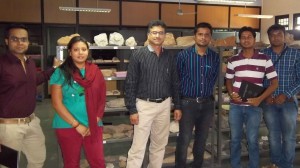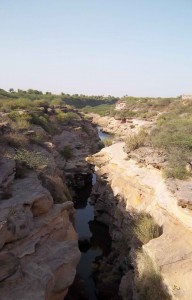10th June 2014 Mumbai, India
Geology, ecology and environment in Kachchh
Kachchh – a tortoise-shaped land situated in the north of Gujarat is a paradise for geologists, environmentalists, and biodiversity enthusiasts! Last month, I visited two Kachchh based institutions located in Bhuj – KSKV Kachchh University and Gujarat Institute of Desert Ecology (GUIDE) – in the dry, blazing summer heat!
I met with Dr. M. G. Thakkar, an enthusiastic geologist, in the Department of Earth and Environmental Science at the university. As he regularly hosts numerous international visitors at the university, he is enormously aware of the richness in the diversity of Kachchh’s topography and ecosystem. Dr. Thakkar told me that UK based universities would benefit tremendously by collaborating in areas such as remote sensing, geographic information system, applied mathematics for earth studies (geodesy), seismology, barcoding of biological diversity, and salt water intrusion. I think there might be some potential for UK-India research partnerships in these specialised geological areas but that remains to be explored. Interestingly, the Centre for Research in Earth Sciences at Plymouth University carries out research along similar lines in active tectonics, tectonic process at plate boundaries, and palaeozoic and mesozoic oceans and climate, to name a few. At Durham University, under the Geohazards theme, a group of researchers are studying the effects of geological processes, such as active fault zones. Durham also hosts research groups focused on palaeoecosystems, palaeoclimate, geodynamics, and geochemistry, among others.
The Jurassic rocks of Kachchh are famous within the geologist community worldwide because they contain body fossils dating back to millions of years ago. While touring the premises, Dr. Thakkar led me into a room (library of rocks!) where he had neatly assembled a rich collection of rock samples, each one of them was handpicked by him and his students during field visits across the Kachchh region and elsewhere in India.
I then popped into the nearby GUIDE, which has the mandate to focus on desert and arid ecosystems of Gujarat. The institute was established with support from centres of excellence in Israel in the early nineties. It’s been nearly two decades, and during my conversation with the Director, Mr. R. V. Asari, it became clear to me that the institute continued to play a key role in pursuing sustainable solutions for the local challenges (ecological, environmental, and geological). Several projects at the institute are examining the consequences of environmental imbalances and vagaries, on the public health. This could fit well with one of the priorities (public health and well being) identified under the anticipated Newton funding programme for India later this year.
 The institute has several ongoing national and international collaborations, and is particularly keen to pursue partnerships in the ecological studies of arid lands. I was pleased to know that GUIDE and the University of Greenwich were joint recipients of the UGC-UKIERI Thematic Partnerships Awards 2013-14 under the strand of innovation partnerships. The project focussed on the ecosystem assessment of the habitats in Kachchh (planning for biodiversity and livelihoods in the future).
The institute has several ongoing national and international collaborations, and is particularly keen to pursue partnerships in the ecological studies of arid lands. I was pleased to know that GUIDE and the University of Greenwich were joint recipients of the UGC-UKIERI Thematic Partnerships Awards 2013-14 under the strand of innovation partnerships. The project focussed on the ecosystem assessment of the habitats in Kachchh (planning for biodiversity and livelihoods in the future).
On our way back to the airport, Dr. Thakkar took a detour to show me a jaw-dropping geological formation, reminiscent of the Grand Canyon (USA) but on a relatively small scale. It seemed as if the earth had aesthetically split to make way for a water channel! Dr. Thakkar often brings his students here to teach geology ‘as is’. Kachchh is indeed a living laboratory!